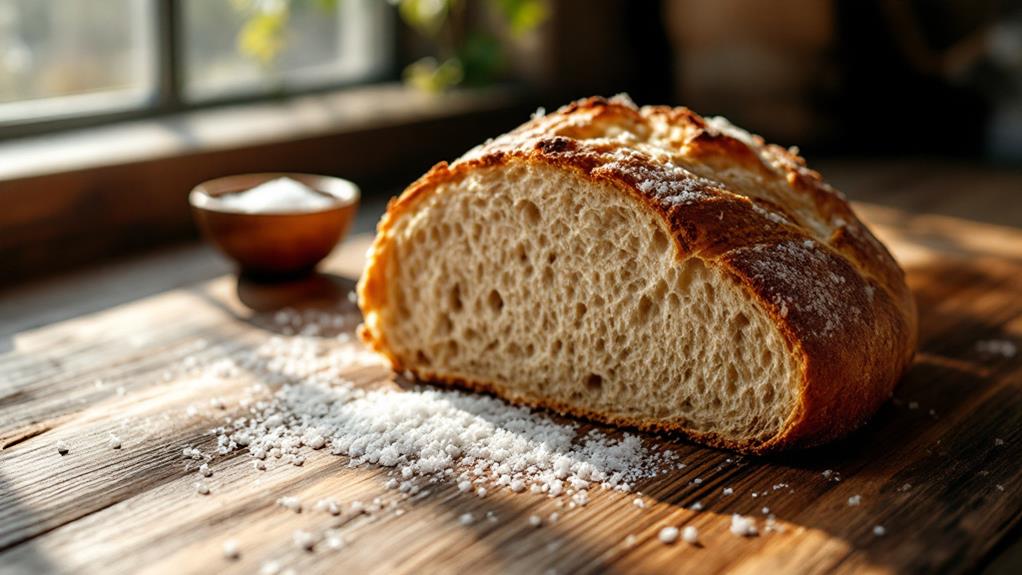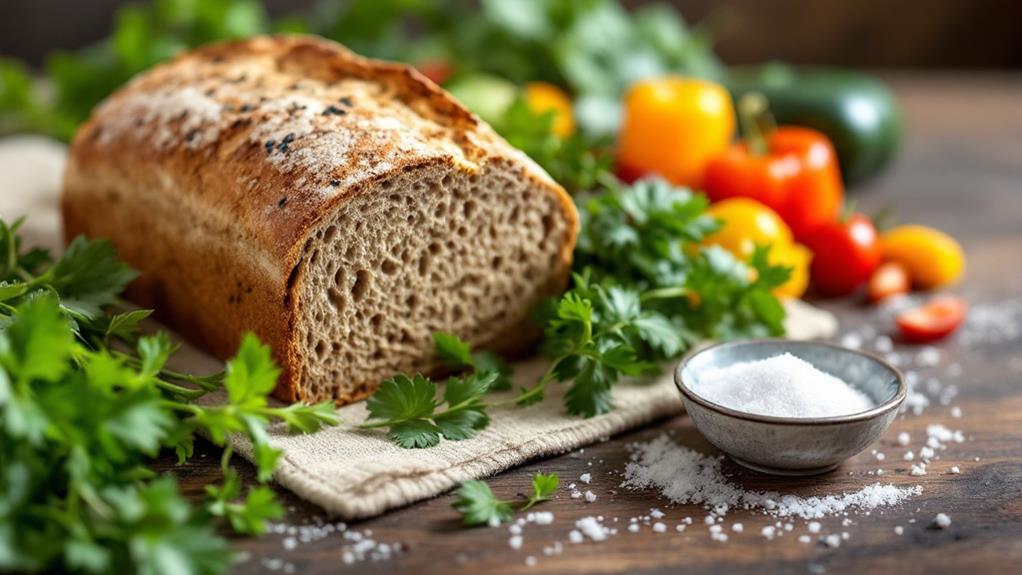The Surprising Link Between Bread and Salt Intake

You might not realize it, but bread is a hidden source of salt and contributes greatly to your daily sodium intake. A single slice of bread can pack around 150 mg of sodium, and some bakery rolls have even more. This isn't just a U.S. issue; bread products here contain about 12% more sodium than those in the UK. Excessive salt consumption can increase your blood pressure and heart disease risk. Reducing your sodium intake, especially from bread, can improve health. Want to reveal more about how everyday foods impact your diet? There's plenty more to find out.
Understanding Sodium in Bread
When you think about sodium in your diet, bread might not be the initial thing that comes to mind, but it's actually a vital contributor. In many Western diets, bread ranks as a leading source of sodium. You might be surprised to learn that a single slice of store-bought bread contains about 150 mg of sodium, and some bakery rolls can pack a whopping 600 mg each. This salt content can rival that of your favorite salty snacks, making bread an unexpected player in salt intake.
Research has shown that over one-third of the breads analyzed surpass the UK's salt target of 1.13g per 100g, highlighting the prevalence of high-sodium options available. Even popular varieties like whole-wheat and flatbreads can have higher sodium levels than you might expect. This means they greatly impact your daily sodium consumption, often accounting for about 20% of your total daily intake.
Being aware of the sodium content in bread is essential for managing your general salt intake. By paying attention to the types of bread you choose, you can better control how much sodium you consume, helping you maintain a more balanced diet.
Health Risks of High Salt
Think about your daily salt consumption, and you might not realize just how much it's affecting your health. High salt intake is a sneaky culprit, primarily because it's hidden in processed foods like bread. These foods contribute to about 80% of your sodium consumption, often pushing your intake well above the recommended 2,300 mg per day. The average American takes in around 3,400 mg, a steep excess that can lead to serious health issues.
One of the biggest risks associated with high salt consumption is raised blood pressure, a major precursor to heart disease and stroke. In fact, approximately 40% of adults over 25 have high blood pressure, which is responsible for nearly 9.4 million deaths annually. It's not just the salt you sprinkle on your meals; it's the sodium lurking in those processed foods that often goes unnoticed.
Reducing your sodium consumption can have tremendous effects on your health. Simple changes, like choosing low-salt bread, can greatly lower blood pressure levels. By being mindful of your sodium intake, you can take active steps toward reducing your risk of heart disease and improving your general well-being.
Sodium Guidelines and Recommendations

The guidelines for sodium intake are clear and vital for maintaining good health. The FDA recommends that you keep your daily sodium intake under 2,300 mg. For even better health benefits, especially if you're on a low-sodium diet, aim for just 1,500 mg. Unfortunately, the average American consumes about 3,400 mg each day, surpassing these recommendations. This excessive intake can lead to serious health issues, making it imperative to be mindful of the sodium content in your diet.
Processed foods, including bread, often contain high levels of sodium, sometimes even comparable to salty snacks. It's significant to be aware of the sodium content in these foods. By doing so, you can take control of your sodium intake and make healthier choices. Public health initiatives are pushing for reduced sodium in staple foods like bread to help curb these numbers and improve general health outcomes.
To manage your dietary sodium effectively, you should check food labels for sodium content and be wary of added salt. By making informed decisions, you can stay within the maximum salt guidelines and contribute positively to your health and well-being.
Bread's Role in Sodium Intake
Bread plays a considerable role in your sodium intake, often without you even realizing it. It's surprising to learn that bread is the top contributor of dietary sodium in the U.S. An average slice contains about 150 mg of sodium, noticeably impacting your total intake. Many bread types exceed the UK's salt target of 1.13g per 100g, showing just how much added salt is hidden in these products. Popular brands like Pepperidge Farms and Whole Foods sometimes have sodium levels comparable to salty snacks, with whole-wheat breads being particularly salty.
The average American consumes around 3,400 mg of sodium daily, and bread accounts for about 20% of this, making it a major player in exceeding recommended sodium limits. This high sodium intake from bread can have serious health implications. Raised sodium levels can increase your blood pressure, raising the risk of heart disease and stroke. Reducing sodium in your diet can be challenging when bread is a staple, but it highlights the need for lower-sodium options. Being mindful of your bread choices and checking labels for sodium content can help you manage your sodium intake and support better heart health.
Global Comparisons of Bread Salt

Many countries have recognized the need to address the high salt content in bread, with significant differences observed in global sodium levels. When comparing bread from the US and the UK, you'll notice that US bread products contain 12% more salt than their UK counterparts. This disparity contributes heavily to sodium intake through prepared foods. In fact, bread accounts for about 20% of the total salt intake in the UK, making it a key factor in daily sodium consumption.
Despite being a staple of whole foods, bread often hides its salt content, particularly in processed and prepared versions. In the US, fewer bread products meet government salt guidelines compared to the UK, highlighting a pressing need for better regulation and awareness. A study examining 4,400 US bread products against 1,600 UK products revealed this hidden salt problem in processed foods.
The UK has successfully reduced salt levels in manufactured foods, including bread, through global initiatives aimed at improving public health. These efforts show the potential for effective strategies to tackle sodium intake in prepared foods, encouraging you to be more mindful of your own bread consumption and its impact on your diet.
Strategies to Reduce Sodium
Reducing sodium intake is crucial for maintaining a healthy diet, and there are effective strategies you can adopt to manage it better. Start by cooking meals from fresh ingredients rather than relying on processed and prepackaged foods, which often contain high sodium levels. When preparing foods at home, aim to reduce salt by experimenting with herbs and spices for flavor. Choosing low-sodium bread alternatives can also be a simple yet effective change, as many breads contain added salt that contributes considerably to daily sodium intake.
Another key strategy is to read food labels carefully. Many packaged foods contain unexpectedly high sodium levels, so checking the sodium content before purchasing can help you make informed decisions. Public health initiatives are pushing for reduced sodium levels in food products, and being aware of the sodium content in bread can lead to healthier habits.
To make smarter choices in the grocery store, consider using tools like the FoodSwitch app. This app helps identify lower salt options, making it easier to select products that align with your dietary goals. By implementing these strategies, you're taking proactive steps toward healthier eating habits.
Benefits of Low-Salt Diets

Adopting a low-salt diet offers numerous health benefits that can greatly enhance your well-being. By reducing your sodium intake, you can considerably lower your systolic blood pressure. Studies show an average decrease of 3.3 mmHg when you cut salt by just 1.7 grams per day. This reduction in blood pressure is vital as it lowers your risk of hypertension and cardiovascular diseases.
To achieve these benefits, focus on minimizing processed foods in your diet. These foods are the main culprits behind high sodium intake. Instead, opt for fresh ingredients and low-salt bread, which help manage blood pressure without compromising your general health. Aim to consume no more than 2,300 mg of sodium daily, as recommended for ideal health outcomes.
The World Health Organization's goal of a 30% reduction in population salt intake by 2025 underscores the public health benefits of low-salt diets. By taking these steps, you not only improve your own health but also contribute to broader public health initiatives. Embracing a low-salt lifestyle can be a powerful way to support both personal well-being and community health goals.
Future Directions in Public Health
In the domain of public health, strategic initiatives are fundamental for tackling high sodium intake, with particular emphasis on products like bread that greatly contribute to this issue. You need to take into account implementing public health initiatives similar to those in the UK to address the salt that's added to bread. Research shows that bread in the US has about 12% more salt than in the UK, underscoring the need for targeted regulation. By monitoring and regulating sodium content, particularly in bread, you can considerably reduce associated health risks like hypertension.
Collaborative efforts with food manufacturers are imperative. By working together, you can implement salt reduction policies effectively. This collaboration can also extend to restaurant meals, where sodium content tends to be high. Encouraging these establishments to lower sodium in their offerings can make a considerable impact on public health.
Public awareness campaigns play a pivotal role, too. Educating consumers about hidden sodium sources in processed foods, including bread, empowers them to make healthier dietary choices. By focusing on these future directions, you can foster an environment where healthier options are accessible, ultimately improving overall public health outcomes.




